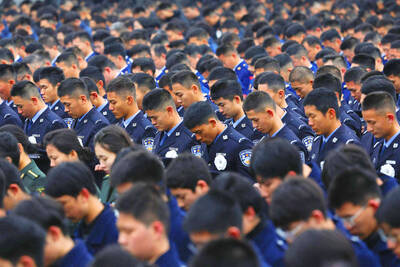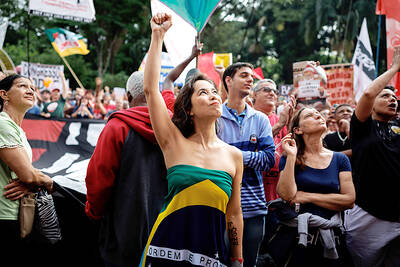In the minutes after the May 12 earthquake, the students lined up row by row on the outdoor basketball courts of Sangzao Middle School. When the head count was complete, their fate was clear: All 2,323 were alive.
Parents covered in blood and dust hugged them and cried. So did the school principal, Ye Zhiping.
“That was the single most joyful thing,” he said.

PHOTO: NY TIMES NEW SERVICE
Given that some 10,000 other children were crushed in their classrooms during the devastating quake, the survival of so many students in Sangzao counts as a minor miracle. Students and parents credit that to the man they call “Angel Ye.”
Nervous about the shoddiness of the buildings, Ye scraped together US$60,000 to renovate it in the 1990s. He had workers widen concrete pillars and insert iron rods into them. He demanded stronger balcony railings. A bathroom whose pipes had been weakened was demolished.
His school in Peace County was very likely to have withstood the 8-magnitude earthquake because he pushed the county government to upgrade it. Just 32km north, the collapse of Beichuan Middle School buried 1,000 students and teachers.
Ye’s tale sheds light on the lax building codes in this mountainous corner of Sichuan Province and what might have been done to address well-known shortcomings. In his case, a personal commitment and a relatively petty amount of cash sufficed to avert tragedy.
“We learned a lesson from this earthquake: The standards for schools should have been improved,” Ye, 55, said in a recent interview. “The standards now are still not enough.”
PREPAREDNESS
Ye not only shored up the building’s structure, but also had students and teachers prepare for a disaster. They rehearsed an emergency evacuation plan twice a year. Because of that, students and teachers say, everyone managed to flee in less than two minutes on May 12.
“We’re very thankful,” said Qiu Yanfang, 62, the grandmother of a student, as she sat outside the school knitting a brown sweater. “The principal helped ease the nation’s loss, both the psychological loss and the physical loss.”
Sangzao is a farming town of 30,000 where merchants sell vegetables from blankets on a rutted market road. It has two middle schools, one administered by the township, where a dormitory collapsed during the earthquake, and the other administered by the county. Ye works in the second, where families from across northern Sichuan send their children because of the school’s reputation.
A large billboard on the school grounds lists the names of 90 students who earned top scores on a national exam last year.
SHODDY CONSTRUCTION
The school is one of the largest in Peace County. It has a half-dozen dormitory buildings and two classroom buildings, all five stories or lower. One of the classroom buildings was constructed after 2000, the other between 1983 and 1985.
The older one worried Ye when he became principal 12 years ago.
It is a four-story white building with large, tinted-glass windows and blue, metal railings running along balconies onto which classrooms open.
“Quality inspectors were supposed to be here to oversee construction of this building,” he said. “When the foundation was laid, they should have been here. When the concrete was put into the pillars, they should have been here. But they weren’t.”
“In the end, no government official dared to come inspect this building because it was built without any standards,” he said.
Ye walked down the hallways with a visitor and pointed to the corners where ceiling met wall. He said workers had stuffed canvas bags and trash into those crevices to seal them. In addition, he said, the surfaces of the walls were coarse rather than smooth, a sign of shoddy construction.
The balcony railings were originally made of cement, not metal. They were shaky and too short, Ye said. They also lacked vertical pillars for support.
“I was among the first teachers who moved into this building, and I was pretty young,” Ye said. “Our awareness of safety wasn’t the same as now.”
TIME TO ACT
He said his attitude changed after he became principal.
“If I knew there was a hidden danger, and I didn’t do anything about it, then I would be the one responsible,” he said.
From 1996 to 1999, Ye oversaw a complete overhaul.
He said that he pestered county officials for money. Eventually the education department gave a total of US$58,000. It was a troublesome process because the county was poor and thus tight with money, Ye said, but officials saw the need to ensure the safety of children.
These days, students dart in and out of the school to grab textbooks, ducking beneath a thin blue ribbon with a handwritten sign that says “Danger.” To them, the building seems sturdy enough.
But Ye said it will be torn down, never again used for classes.

China yesterday held a low-key memorial ceremony for the 1937 Nanjing Massacre, with Chinese President Xi Jinping (習近平) not attending, despite a diplomatic crisis between Beijing and Tokyo over Taiwan. Beijing has raged at Tokyo since Japanese Prime Minister Sanae Takaichi last month said that a hypothetical Chinese attack on Taiwan could trigger a military response from Japan. China and Japan have long sparred over their painful history. China consistently reminds its people of the 1937 Nanjing Massacre, in which it says Japanese troops killed 300,000 people in what was then its capital. A post-World War II Allied tribunal put the death toll

‘NO AMNESTY’: Tens of thousands of people joined the rally against a bill that would slash the former president’s prison term; President Lula has said he would veto the bill Tens of thousands of Brazilians on Sunday demonstrated against a bill that advanced in Congress this week that would reduce the time former president Jair Bolsonaro spends behind bars following his sentence of more than 27 years for attempting a coup. Protests took place in the capital, Brasilia, and in other major cities across the nation, including Sao Paulo, Florianopolis, Salvador and Recife. On Copacabana’s boardwalk in Rio de Janeiro, crowds composed of left-wing voters chanted “No amnesty” and “Out with Hugo Motta,” a reference to the speaker of the lower house, which approved the bill on Wednesday last week. It is

FALLEN: The nine soldiers who were killed while carrying out combat and engineering tasks in Russia were given the title of Hero of the Democratic People’s Republic of Korea North Korean leader Kim Jong-un attended a welcoming ceremony for an army engineering unit that had returned home after carrying out duties in Russia, North Korean state media KCNA reported on Saturday. In a speech carried by KCNA, Kim praised officers and soldiers of the 528th Regiment of Engineers of the Korean People’s Army (KPA) for “heroic” conduct and “mass heroism” in fulfilling orders issued by the ruling Workers’ Party of Korea during a 120-day overseas deployment. Video footage released by North Korea showed uniformed soldiers disembarking from an aircraft, Kim hugging a soldier seated in a wheelchair, and soldiers and officials

The Burmese junta has said that detained former leader Aung San Suu Kyi is “in good health,” a day after her son said he has received little information about the 80-year-old’s condition and fears she could die without him knowing. In an interview in Tokyo earlier this week, Kim Aris said he had not heard from his mother in years and believes she is being held incommunicado in the capital, Naypyidaw. Aung San Suu Kyi, a Nobel Peace Prize laureate, was detained after a 2021 military coup that ousted her elected civilian government and sparked a civil war. She is serving a